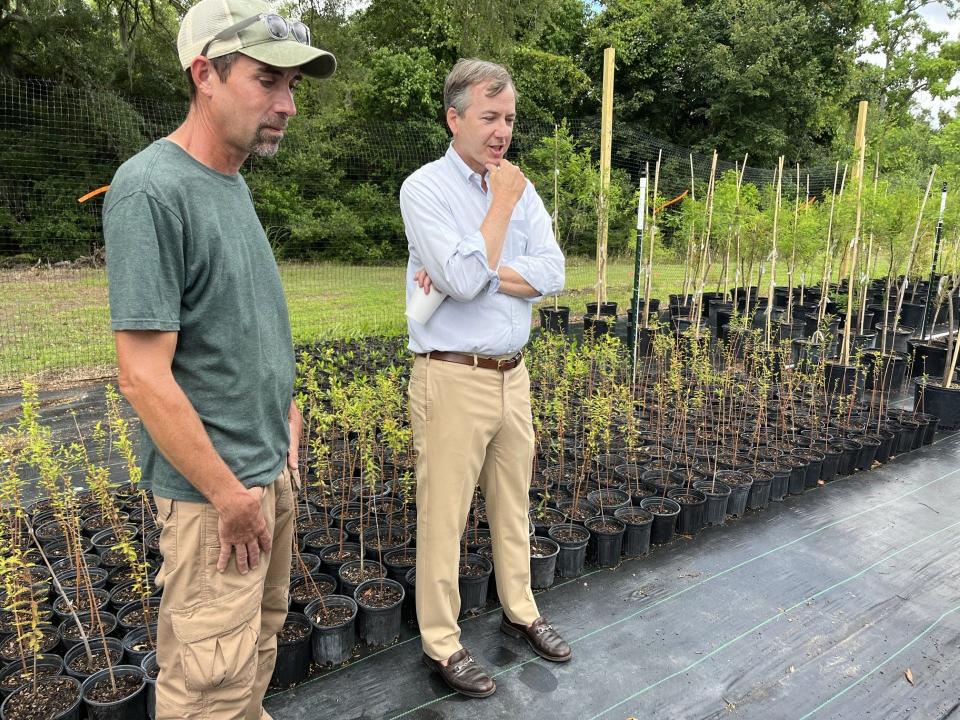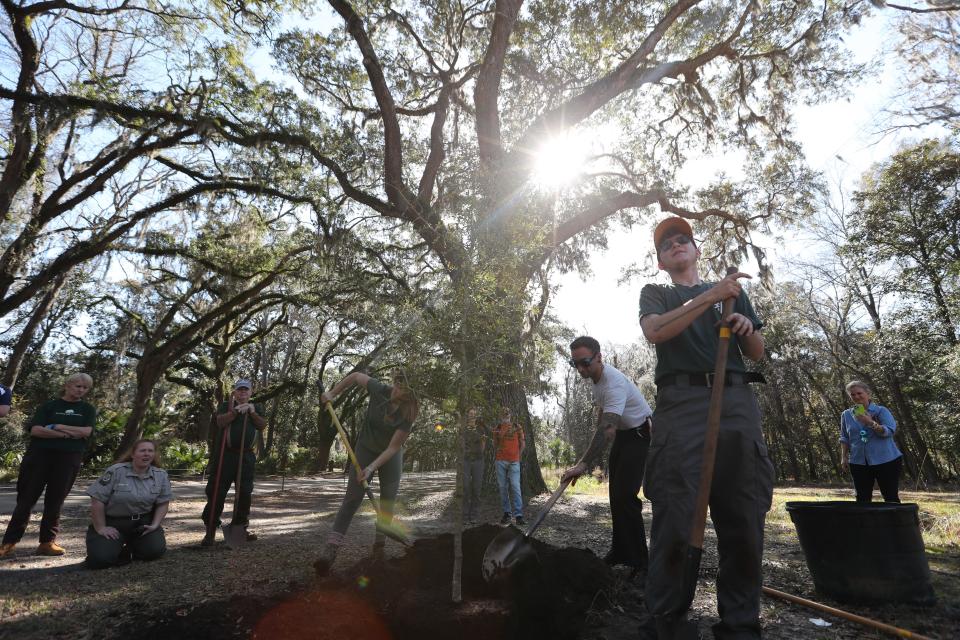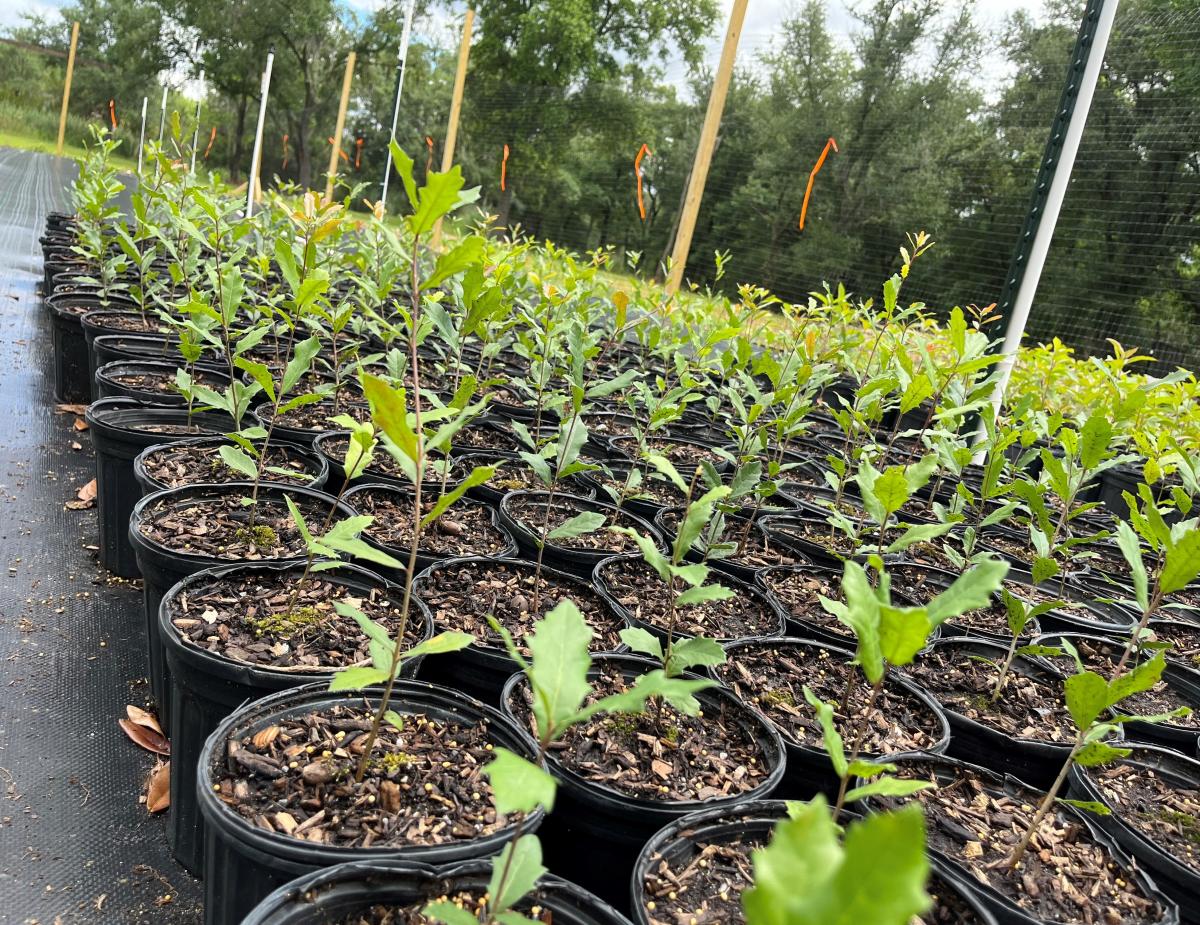On a sun-drenched weekday morning, an imposing icon from Savannah’s past stands guard at the gate of a gated compound that protects the ingredients for the city’s future.
A colossal live oak, with Spanish moss draped like tattered scarves over its gnarled arms, seems to peer over the edge of the forest. Within the fence, neatly arranged rows of young live oaks in small, black containers await their deployment.
“We have an aging canopy,” explains Savannah Tree Foundation Executive Director Zoe Rinker, standing in a muddy meadow at the SeaPoint Industrial Terminal Complex. “What is not lost to storms is growing older and not being replanted at the rate it should.”
Rinker wants to change that, and thanks to a partnership with the company that operates SeaPoint, her organization now has the first comprehensive supply of local seedlings.
About 1,500 early-stage trees now occupy part of the outdoor nursery. Eventually that number will grow to 4,000.
While a continuously replenished supply will protect the base from shortages like the one the country is now experiencing, local seedlings are more likely to get off to a healthy start, Rinker noted.
“What it lets us do is grow trees in the microclimate of Savannah,” she says. “There are so many times when we transplant trees from Florida or North Georgia that have a harder time acclimating to (being at) sea level and our temperatures. So that really helped us a lot with the survivability.”
With the future addition of a greenhouse on the property, the foundation hopes to propagate seeds from Savannah landmarks such as the Candler Oak, believed to be three centuries old, and the iconic collection of live oaks at the former Wormsloe Plantation.
“This space is perfect,” Rinker says before pointing to Matt White, manager of the operation. “I didn’t know anything about daycares, and I brought Matt here during his interview and said, ‘Can we work with this?’ He said yes!'”
Dulany Industries Inc. donated the use of the one-acre site near SeaPoint’s one-megawatt solar array, honeybee apiary and pollinator garden. The company will also supply water and electricity for the nursery.
“’Rarely do you have organizations or people that think very progressively,’ says Reed Dulany III, chairman and CEO of Dulany Industries, when asked why he became interested in the project. ‘Trees are one of the things Savannah is famous for. Who does that?’ Don’t you like trees? And yet at some point they will die.’
To look up: A $1 million grant to address Savannah’s ‘tree disparity’ offers a nontraditional job path

Before the heat
The majority of the trees grown at the farm will go to private property owners, and many of them will be destined for underserved – and under-shaded – areas, including Savannah’s west side.
“Usually in West Savannah, the canopy is lacking because the city doesn’t have a priority to plant trees anywhere,” Rinker explains. “It was just designed differently than, for example, the center.”
Adding trees to that part of the city will be particularly beneficial because the continued burning of fossil fuels for transportation and energy production creates more heat-trapping pollution, leading to more instances of extremely hot weather.
The shade of a canopy keeps neighborhoods cooler and protects residents from exposed “heat islands” where temperatures can reach dangerous levels.
Research has found that urban neighborhoods can experience mid-afternoon temperatures that are 15 to 20 degrees warmer than nearby tree-lined communities or rural areas with fewer people and buildings.
That’s important because excessive heat is the leading cause of weather-related deaths in the US
Savannah already has an average of 23 more summer days with temperatures that are higher than normal than half a century ago, according to an analysis by the organization Climate Central.
In addition to casting valuable shade, trees and vegetation also absorb moisture through their roots and a cool environment by releasing water vapor into the air through their leaves and through evaporation from rainfall that collects on leaves and soil.
Much of the foundation’s private placement will be through the Canopy Corps program, which addresses tree inequality and provides green job training opportunities in Chatham County.
The effort got a boost earlier this year thanks to a $1 million grant from the Georgia Forestry Commission.
“We are trying to do some planting on private land, but on a scale that is not such that we place a disproportionate amount of the maintenance responsibility on the private owner,” Rinker says.
As a black swallowtail butterfly flashes behind Rinker, she takes a page from her own life to illustrate the potential planted in each of the nursery’s 1,500 containers.
As a child living in the Old Towne community on Wilmington Island, Rinker watched as a swath of forest was cleared to make room for more development.


“But now that I go back, there are live oaks along the lagoon and other trees that looked just like sticks at the time,” she says. “To some extent they did it well. They saved many trees. So yes, even if this isn’t the best plan, there’s still a lot you can do to ensure there’s a quality, livable future.
John Deem addresses climate change and the environment in coastal Georgia. He can be reached at 980-355-2995.
This article originally appeared on Savannah Morning News: Savannah Tree Foundation to tap local seedlings for equity






